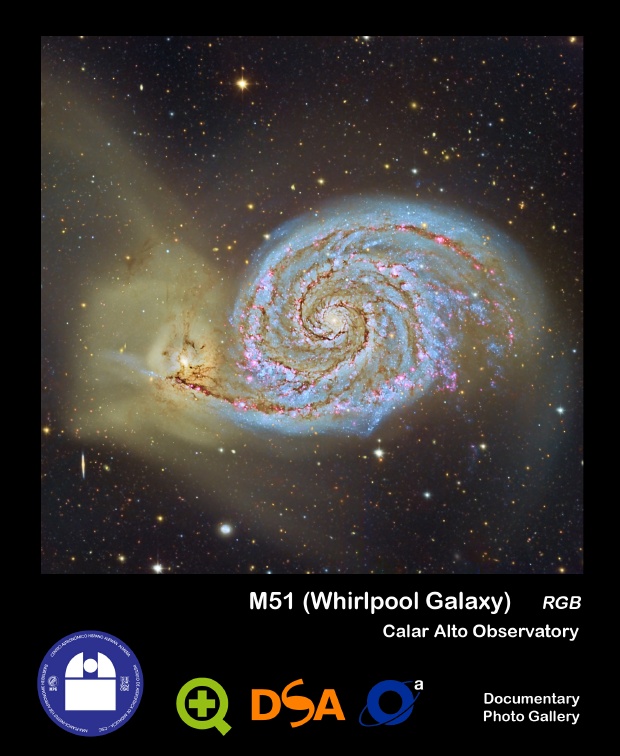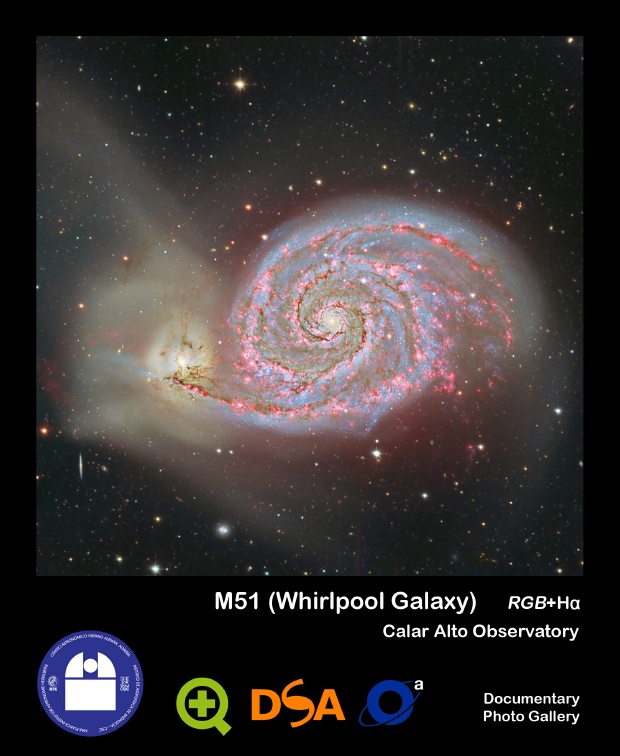These two stellar systems are colliding and the spiral shape of M51 is due to the tidal forces unleashed during this process. At a distance of 23 millions of light-years, the apparent dimensions of M51 mean that that galaxy has to be quite similar to our own, yet somewhat smaller.
M51 and its companion NGC 5195 are performing a cosmic dance that, during the last 500 million years has made NGC 5195 pass twice through the disk of M51. Now, the small galaxy is located slightly behind the disc of the Whirlpool, and moving away from us.
The interaction of both galaxies induces a bunch of collateral effects, being the spiral structure of the main galaxy only one of them. When galaxies collide, their stars do not crash ones against the others. Instead, they suffer strong alterations in their trajectories, what usually implies that many of them are expelled into the intergalactic space. This has happened to many stars from the secondary galaxy: streams of stars stripped of from NGC 5195 extend over the left (north) part of the image as a fuzzy fog. Many of the worlds in that area are doomed to get lost into the emptiness of space, as they move far away from their parent galaxies.
The gaseous content of colliding galaxies gets compressed and this triggers violent bursts of star formation (starbursts). Star forming regions can be detected thanks to the pinkish glow of ionized hydrogen. Images taken in the so-called H-alpha color reveal where the gas is ionized by newborn stars. For this reason, we offer the M51 image in two versions: true color and H-alpha enhanced.

The true-color image has been obtained gathering light through a set of three filters that mimic the chromatic sensitivity of the human eye. The final color balance has been done in such a way that the light coming from both galaxies, put together, is considered as white. This way, the contrast among the different stellar populations in the field is more obvious. Particularly, the spiral galaxy exhibits bluish hues due to the massive, young and hot stars that populate its disk. This contrasts with the yellowish colors in the satellite galaxy, coming from lighter, older and colder stars.
M51 displays a star-forming activity much stronger than isolated galaxies like our own. This fact is highlighted in the H-alpha-enhanced image. As could be expected, star-forming activity closely follows the areas where younger and more massive stars are seen: the bluish spiral arms. But H-alpha emissions in M51 are not restricted to the spiral arms, but extend also into other areas. One of the most outstanding and intriguing features of this image is the fuzzy region of faint H-alpha emission to the north (left) of NGC 5195, a detail seldom seen before and closely related, too, to the effects of the collision on the gaseous content of these galaxies.

Many of the tiny points in the image are stars belonging to our own Galaxy. But a detailed inspection reveals that most of the small spots are other background galaxies. Small and remote extragalactic systems, of many shapes and colors, can be seen down to the edge of infinity in this photo. The two most outstanding background galaxies are the bright edge-on spiral galaxy IC 4277 seen close to the lower left (north-east) corner of the frame, and the small irregular galaxy IC 4278, to the right of the previous one, below (east) from the bridge of stars that seems to link M51 with NGC 5195.
This image has been obtained with the Zeiss 1.23 m reflector of Calar Alto Observatory (CAHA) as a part of the Public Outreach Project conducted by Foundation Descubre with this instrument. The observations have been planned and carried out by the Documentary School of Astrophotography (DSA), and the data have been processed by this organisation with the collaboration of the Astronomical Observatory of the University of Valencia (OAUV), using the software package PixInsight.





Comments